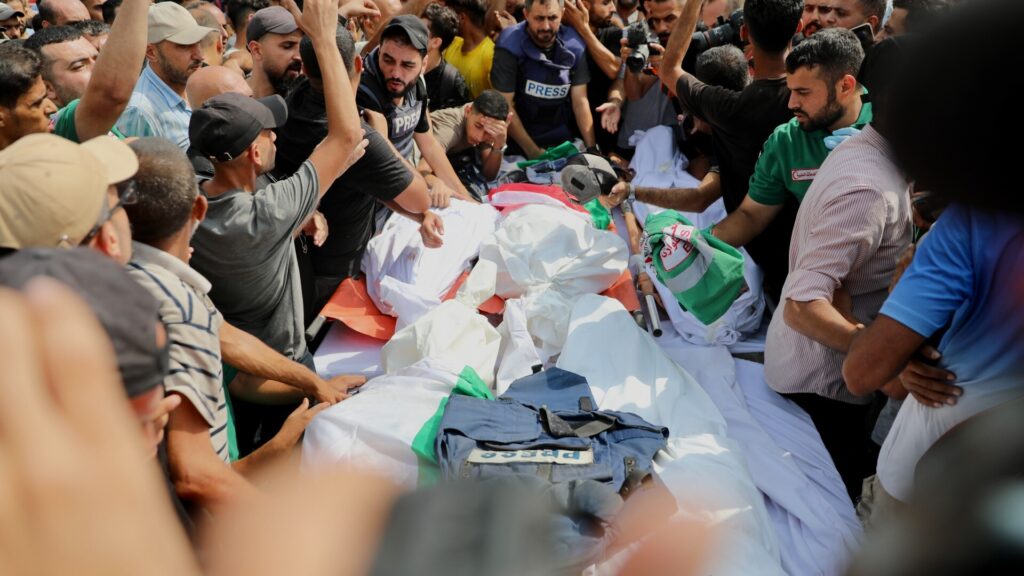With press vests laid atop their bodies, six more Palestinian journalists targeted and killed by Israeli forces were laid to rest on Monday.
It was a scene that had played out devastatingly frequently over the past 22 months: reporters with the word “press” proudly displayed on their jackets gathering to grieve and pray for slain colleagues.
Anas al-Sharif, Middle East Eye contributor Mohammed Qreiqeh, Ibrahim Zaher, Mohammed Noufal, Moamen Aliwa and Mohammed al-Khalidi were the latest names among 238 journalists killed by Israeli forces in Gaza since the war began in October 2023.
Their media tent, set up outside al-Shifa hospital in Gaza City, was deliberately targeted late on Sunday night.
Medhat al-Sawalha, whose own tent is metres away, saw the aftermath of the attack.
New MEE newsletter: Jerusalem Dispatch
Sign up to get the latest insights and analysis on
Israel-Palestine, alongside Turkey Unpacked and other MEE newsletters
“I went out to buy something from a stall,” he told Middle East Eye, adding that he returned to see Sharif and his colleagues’ tent on fire.
“I didn’t hear the sound of the explosion, but at home they told me they heard it.”
He rushed over, only to find Sharif and several others dead and dismembered.
“Anas, may God have mercy on him, I carried him in my hands,” said Sawalha. “I carried him in my hands.”
He said he saw another body next to Sharif’s, which he couldn’t identify. The body was missing a head.
‘We were closer than family’
Hours after the attack, Palestinian journalists returned to the encampment.
The structure of the tent had been completely blown off, with mattresses and destroyed belongings strewn across the floor.
The reporters mourned and documented – a familiar blurring of the personal and professional that Palestinian journalists have endured since the war on Gaza began.
It’s a feeling that Mohammed Abu Namous, a broadcast journalist in Gaza, is used to.
“Imagine, yesterday when I arrived at the targeted site in the middle of the night, I went live on air,” he told MEE.
“With one hand I was speaking to the channel live on air. With the other hand, I was trying to reassure my family through text messages on WhatsApp that I’m fine.”
‘Imagine, yesterday when I arrived at the targeted site in the middle of the night, I went live on air’
– Mohammed Abu Namous, broadcast journalist
Addressing journalists around the world, Abu Namous said the least they could do was protect their Palestinian colleagues from Israeli attacks.
“What is the difference between a foreign journalist and a journalist in the Gaza Strip?” he asked. “In the eyes of the Israeli occupation, all Palestinians are the ones who must be killed at any moment.”
Ramadan Abu Sakran was a colleague and close friend of Sharif, Qreiqeh and Zaher.
“We were closer than family because we slept in the same place, in the same surroundings, and shared our food and drink,” he told MEE.
“We lived through the same fear, the same atmosphere of being targeted. We used to cover the same targeted sites together, and we would console each other about the scenes we saw daily in the places we covered together.”
He said Sharif was full of laughter and jokes, often trying to lift the spirits of his friends and fellow reporters.
He even joked, after Israel’s army issued a threat last year stating that it would target him and fellow Al Jazeera journalist Hossam Shabat, that his friends should stay away from him.
“We’d say, ‘If we’re going to die, we’ll die together.’ That’s how we used to comfort each other,” said Abu Sakran.
Unsubstantiated Israeli claims
Shabat was killed in March, in an attack which deliberately targeted his vehicle in northern Gaza.
The Israeli military claimed, without providing any credible evidence, that it killed Sharif because he “served as the head of a terrorist cell in the Hamas terrorist organisation”.
Israel has routinely made such claims about journalists, which have been strongly rejected by the Committee to Protect Journalists. It made the same claims about Shabat in March.
Al Jazeera, for whom Sharif was one of the most prominent on-screen reporters based in Gaza, described him as “one of Gaza’s bravest journalists”.
It said the attack was “a desperate attempt to silence voices in anticipation of the occupation of Gaza”.
“These journalists were the ones who conveyed the clear truth without embellishment or distortion to the entire world,” Tamer Daloul, a correspondent for Al-Ghad TV in Gaza City, told MEE.
“It should be noted that Anas and Mohammed Qreiqeh remained steadfast in northern Gaza during the displacement and division between the north and the south,” he added.
“They insisted on staying inside the Ahli Arab Baptist Hospital, in a tent, and later moved to al-Shifa medical complex, in the well-known tent [where they were killed].”
Daloul said the Israeli targeting of these journalists, among the over 200 others, leaves him fearful – not just for himself, but for his family too.
“It left us honestly not knowing, should we continue covering, should we stop, should we keep going live, are we protected?” he said. “We no longer sleep at our families’ homes for fear of being targeted.
“And yet, despite all this, we try to keep going and continue doing everything we can.”


